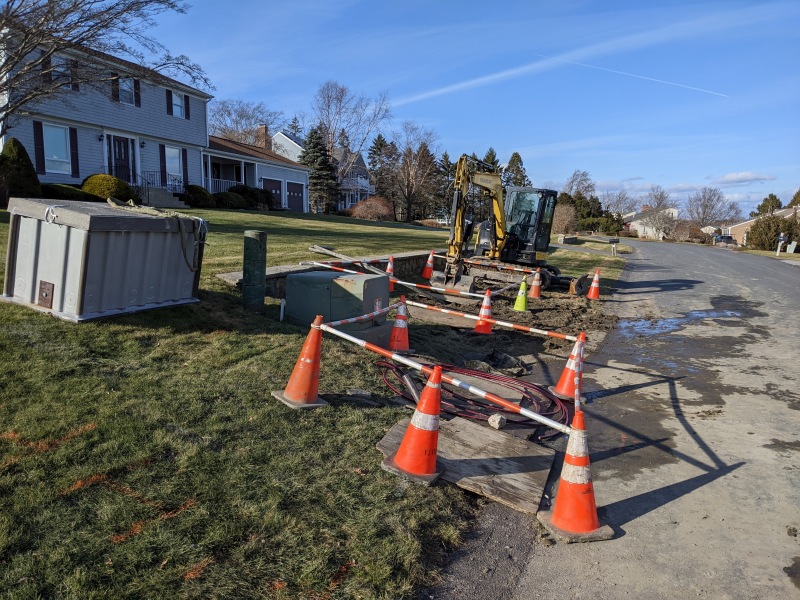
Since the beginning of January, Rhode Island Energy has been digging trenches and laying conduit underground along Adams Drive in Portsmouth, RI. This is a really big job requiring several crews and lots of heavy equipment. So what’s the reason for this and why now? Here’s the story:
Emergency Electrical Call Three Years Ago
Several homes on the same street have been experiencing random power outages. In fact, Griff Electric was called to troubleshoot an electrical problem for a home on the same street during early 2020.
The customer noticed flickering lights and an unexplained power outage in parts of the house. After the local energy company confirmed that the equipment they manage was operating correctly, we did some investigating and discovered that the “hot” wire, which carries electricity from the breaker panel into the home, had been damaged. The solution was to replace the wire and protect it with electrical conduit. Our crew dug up the old wires, laid down the conduit, and pulled the wires through. Luckily, we were able to restore power to the home the same day the customer called us.
Electrical Mystery Uncovered
It appears that when this neighborhood was built, the electrical cable was buried directly in the soil without conduit. Conduit is a hollow tube that protects the cables from being severed or disturbed by yard work or even animals chewing on wires. Since all the power lines in this neighborhood are buried underground, it seems that over time some of the wires have become damaged. When buried wires are not protected by conduit, it’s almost inevitable that they will become damaged.
Safely Bury Electrical Cable Underground
Some homeowners bury cables underground to run electrical power to a garage, shed, or decorative pond. While many choose to hire a licensed electrician to do the job, it can also be a realistic DIY project. In Rhode Island, the owner of a single-family, owner-occupied home is permitted to do the work without hiring a licensed electrician. (A licensed contractor must be hired for non-owner-occupied, commercial, and two-family homes.)
If you’re considering burying electrical cables on your property, here are some things to keep in mind:
- Inspection. Check with your local building inspection department to find out if an electrical permit and inspections are required. Before you bury the wire, you can have the electrical inspector confirm that the depth of the trench is correct. The peace of mind you’ll get from having a professional ensure the safety of your work is worth the cost of the inspection fee.
- Mark Utilities. To have your utilities marked before you begin digging, dial 811 or visit www.call811.com. This will ensure that you won’t interfere with the public utility infrastructure such as electric, gas, water, and more. Digging in the wrong spot could render your neighborhood’s utilities inoperable for several hours or days and possibly even subject you to legal action.
- Barricade. Install barricades around the trench while it’s open to protect both people and animals.
- National Electrical Code. Be sure to adhere to the required wiring methods, materials, burial depth of the wiring, and other safety considerations outlined in the National Electrical Code.
Lesson Learned
So what’s the main takeaway from the repair work on Adams Drive? Do it right the first time. Burying electrical wires on your property requires proper planning and safety measures, but done right, it can enhance both the look and function of your home. Give us a call if this is a project you’re considering. Call us at (401) 293-5255 or email Valerie@GriffElectric.com.


